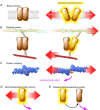Polycystins and partners: proposed role in mechanosensitivity
- PMID: 24687583
- PMCID: PMC4080931
- DOI: 10.1113/jphysiol.2014.271346
Polycystins and partners: proposed role in mechanosensitivity
Abstract
Mutations of the two polycystins, PC1 and PC2, lead to polycystic kidney disease. Polycystins are able to form complexes with numerous families of proteins that have been suggested to participate in mechanical sensing. The proposed role of polycystins and their partners in the kidney primary cilium is to sense urine flow. A role for polycystins in mechanosensing has also been shown in other cell types such as vascular smooth muscle cells and cardiac myocytes. At the plasma membrane, polycystins interact with diverse ion channels of the TRP family and with stretch-activated channels (Piezos, TREKs). The actin cytoskeleton and its interacting proteins, such as filamin A, have been shown to be essential for these interactions. Numerous proteins involved in cell-cell and cell-extracellular matrix junctions interact with PC1 and/or PC2. These multimeric protein complexes are important for cell structure integrity, the transmission of force, as well as for mechanosensing and mechanotransduction. A group of polycystin partners are also involved in subcellular trafficking mechanisms. Finally, PC1 and especially PC2 interact with elements of the endoplasmic reticulum and are essential components of calcium homeostasis. In conclusion, we propose that both PC1 and PC2 act as conductors to tune the overall cellular mechanosensitivity.
© 2014 The Authors. The Journal of Physiology © 2014 The Physiological Society.
Figures




Similar articles
-
Structure and function of polycystins: insights into polycystic kidney disease.Nat Rev Nephrol. 2019 Jul;15(7):412-422. doi: 10.1038/s41581-019-0143-6. Nat Rev Nephrol. 2019. PMID: 30948841 Review.
-
Polycystins and renovascular mechanosensory transduction.Nat Rev Nephrol. 2010 Sep;6(9):530-8. doi: 10.1038/nrneph.2010.97. Epub 2010 Jul 13. Nat Rev Nephrol. 2010. PMID: 20625375 Review.
-
Polycystins and mechanotransduction: From physiology to disease.World J Exp Med. 2015 Nov 20;5(4):200-5. doi: 10.5493/wjem.v5.i4.200. eCollection 2015 Nov 20. World J Exp Med. 2015. PMID: 26618106 Free PMC article.
-
Polycystin-2 Is Required for Chondrocyte Mechanotransduction and Traffics to the Primary Cilium in Response to Mechanical Stimulation.Int J Mol Sci. 2021 Apr 21;22(9):4313. doi: 10.3390/ijms22094313. Int J Mol Sci. 2021. PMID: 33919210 Free PMC article.
-
Regulation of polycystin expression, maturation and trafficking.Cell Signal. 2020 Aug;72:109630. doi: 10.1016/j.cellsig.2020.109630. Epub 2020 Apr 8. Cell Signal. 2020. PMID: 32275942 Free PMC article. Review.
Cited by
-
Polycystin-1 affects cancer cell behaviour and interacts with mTOR and Jak signalling pathways in cancer cell lines.J Cell Mol Med. 2019 Sep;23(9):6215-6227. doi: 10.1111/jcmm.14506. Epub 2019 Jun 28. J Cell Mol Med. 2019. PMID: 31251475 Free PMC article.
-
Modulation of polycystic kidney disease by G-protein coupled receptors and cyclic AMP signaling.Cell Signal. 2020 Aug;72:109649. doi: 10.1016/j.cellsig.2020.109649. Epub 2020 Apr 23. Cell Signal. 2020. PMID: 32335259 Free PMC article. Review.
-
Mating behavior, male sensory cilia, and polycystins in Caenorhabditis elegans.Semin Cell Dev Biol. 2014 Sep;33:25-33. doi: 10.1016/j.semcdb.2014.06.001. Epub 2014 Jun 27. Semin Cell Dev Biol. 2014. PMID: 24977333 Free PMC article. Review.
-
Human podocytes express functional thermosensitive TRPV channels.Br J Pharmacol. 2017 Dec;174(23):4493-4507. doi: 10.1111/bph.14052. Epub 2017 Nov 2. Br J Pharmacol. 2017. PMID: 28945920 Free PMC article.
-
The role of mechanosensitive ion channels in the gastrointestinal tract.Front Physiol. 2022 Aug 19;13:904203. doi: 10.3389/fphys.2022.904203. eCollection 2022. Front Physiol. 2022. PMID: 36060694 Free PMC article. Review.
References
-
- Alenghat FJ, Nauli SM, Kolb R, Zhou J, Ingber DE. Global cytoskeletal control of mechanotransduction in kidney epithelial cells. Exp Cell Res. 2004;301:23–30. - PubMed
-
- Arnadottir J, Chalfie M. Eukaryotic mechanosensitive channels. Annu Rev Biophys. 2010;39:111–137. - PubMed
-
- Arnould T, Kim E, Tsiokas L, Jochimsen F, Grüning W, Chang JD, Walz G. The polycystic kidney disease 1 gene product mediates protein kinase C α–dependent and c-Jun N-terminal kinase-dependent activation of the transcription factor AP 1. J Biol Chem. 1998;273:6013–6018. - PubMed
Publication types
MeSH terms
Substances
LinkOut - more resources
Full Text Sources
Other Literature Sources
Research Materials
Miscellaneous

